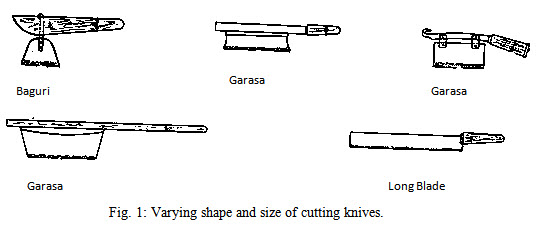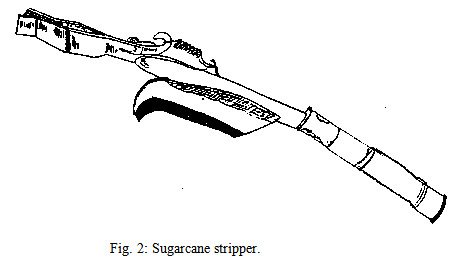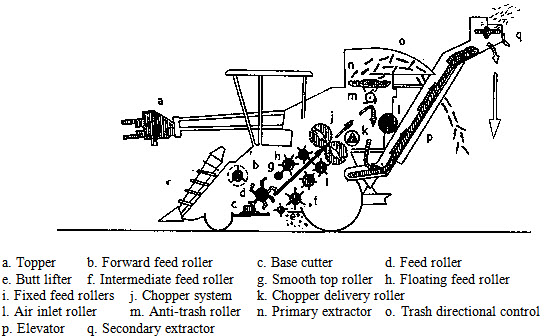Site pages
Current course
Participants
General
MODULE 1. PRINCIPLES AND TYPES OF CUTTING MECHANISM
MODULE 2. CONSTRUCTION AND ADJUSTMENT OF SHEAR AND...
MODULE 3. CROP HARVESTING MACHINERY
MODULE 4. FORAGE HARVESTING, CHOPPING AND HANLING ...
MODULE 5. THRESHING MECHANICS, TYPES OF THRESHES, ...
MODULE 6. MAIZE HARVESTING AND SHELLING EQUIPMENT
MODULE 7. ROOT CROP HARVESTING EQUIPMENT
MODULE 8. COTTON PICKING AND SUGARCANE HARVESTING ...
MODULE 9. PRINCIPLES OF FRUIT HARVESTING TOOLS AND...
MODULE 10. HORTICULTURAL TOOLS AND GADGETS
LESSON 20. SUGARCANE HARVESTERS - CONSTRUCTION AND WORKING PRINCIPLES
Sugarcane is a native crop of India. It is grown in tropical and sub-tropical climates of developing countries of Asia, Africa and Latin America. Australia and USA are the major sugarcane producing countries of the developed world. Sugarcane cultivation practices vary from country to country and within a country. For example, row to row spacing in India varies from 60 to 100 cm while in many other countries from 150 to 180 cm. Sugarcane is planted in furrows or on ridges or in flat fields. Varying cultivation practices introduce a number of design constraints on sugarcane harvesting machines. Most of the sugarcane harvesting in India and other developing countries is manual. Cutting knives of varying sizes and shapes are used (Fig. 1). De-husking, cleaning, bundling of cut cane and loading for transportation are done manually. Indian Institute of Sugarcane Research (IISR), Lucknow has developed a sugarcane stripper (Fig. 2) which does the job of detopping and dressing of the cane.
Sugarcane harvesting involves base cutting of the crop, detopping, detrashing, bundling, loading and transportation. Detopping and detrashing of crop itself takes about two-third of manpower required for harvesting. Several types of sugarcane combines and harvesters are used world over. They are normally used for crops, which are burnt in the field prior to harvesting for trash removal. Some harvesters are used in green crop and cane is burnt in windrow after harvesting. Some machines have been developed which can be used in the cane field without burning. This is particularly done where environmentalists object burning of cane. The sugarcane combine is a one-pass machine, which cuts the cane, detops, cuts in billets, cleans and conveys to transport cart/trolley. In case of sugarcane harvester, it cuts the crop, detop and put on the ground in windrow, which are loaded in trolleys by mechanical loader or grabber. Combine harvested cane must be processed within 16 hours to avoid deterioration and sucrose loss. Most of the sugarcane combines and harvesters is self-propelled machine. However, some tractor-drawn machines are also available. Some of the most widely used sugarcane harvesting systems are discussed below.


Push-rake system: Push-rake system involves pushing and piling of sugarcane. It is made of very sturdy tines welded to a frame. It is mounted in front of tractor. When machine is pushed into standing cane in the field, it breaks the stalks off at the surface of ground and leaves them in piles. The piles of cane is then loaded into truck and delivered to the mills. The main drawback of this machine is that the cane is not topped and cane delivered to mill contains ¼ to one-third of trash. It uproots cane plants, which results in poor ratoon crop.
Windrow harvest system: In this system, sugarcane is cut and windrowed. It has V-cutter harvest system and soldier type harvester. The V-cutter harvest system has two circular horizontal blades spaced at 152.4 cm. The machine cuts the cane in the field and makes a windrow of two rows. The crop harvested by this machine has also a very high percentage of trash. The unit is mounted on a track-type tractor. The front end of the machine can be raised or lowered hydraulically for transport and field operations. The effective field capacity of the machine is about 0.8ha/h.
Soldier-type cane harvester tops the cane, cuts the cane from base and places in windrow for mechanical loading. It cuts one row of green cane at a time. A topper with a gathering chain and two discs remove the top from standing crop and drop towards right of row being harvested. Two sets of pick-up chains arranged in a V are used for picking and feeding the cane to the base cutter. The harvested cane is conveyed through a cane conveying system to the windrow. Both the operations of topping and base cutting are performed simultaneously. It does not uproot the cane and its capacity is about 0.4 ha/h.
McConnel sugarcane harvesting system: In this system, the machine is mounted on a tractor of 75-90 hp. The machine cuts the top green portion of sugarcane, harvests from the base, cleans the cane and places in a windrow. The cane is further cleaned by labour and loaded manually or mechanically in the truck. It harvests one row at a time.
Cut-crop-harvest or combine harvest system
All harvest system described so far namely push, pile and grab system and windrow harvest system have one operation in common. It is the cane being placed on ground for loading after cutting. This operation is partly responsible for cane left in the field and soil and rocks delivered to the mill. A combine harvest system eliminates this operation. The basic components of a sugarcane combine are:
(i) Gathering mechanism
(ii) Topping mechanism
(iii) Base cuter
(iv) Feed conveyor
(v) Chopper
(vi) Elevator
(vii) Cleaning by air blast
Gathering mechanism: Its function is to separate sprawled cane and align the row to be harvested. They are made of revolving scrolls fitted on gathering walls. It consists of two triangular walls, approximately 140 cm apart at the tips and converging to the throat width of the machine just forward of the base cutters. The tips of each wall are fitted with ground engaging points to get under and lift stalks that are lying on the ground.
Topping mechanism: Its job is to gather, cut and discard non productive tops. The gathering operation is performed by gathering chains while cutting is done by a horizontally rotating disc fitted with mower blades which cut against a fixed anvil.
Base cutter: Its function is to cut the stalk at or just below ground level. At least one manufacture uses twin contra-rotating discs fitted with a number of replaceable knife blades. Some use single diameter blades for base cutting the cane. Researchers have found that tip speeds below 304.8 m/min do a very poor job of cutting. Recommended tip speeds for Florida conditions is 1524 to 1828 m/min.
Feed conveyor: Its function is to convey the whole stalks of cane from the bass cutter to the choppers. In some machines it is made of endless chain slat conveyor. In others a series of rollers are used. In some machines augers are used for feeding cane to the chopper.
Choppers: Their function is to receive the whole stalks from the feed conveyor and chop them into short uniform billets. The design used by Massey Ferguson is a pair of parallel shafts each with paddle shaped blades, which as they rotated came together in the plane containing the shafts, and so gave a flying or travelling cut. There is other mechanism used for chopping. However, flying cut mechanism has the advantage of being aggressively self-feeding, and that once the swath is engaged by the chopper; it will be pulled in continuously until broken or forcibly interrupted.
Elevator: Its function is to receive the billets from the choppers and convey them into a receptacle for transporting to the mill. An inclined chain and slat conveyor is used. The elevator can be rotated 180 degrees in most machines. This facilitates in opening of the field and harvesting in either direction.
Air-blast cleaning: One of the biggest problems with mechanically harvested cane is the foreign matter in cane delivered to the mill. Foreign matter consists of leaves, tops, dirt, stones and many other materials picked from the field. In some machines one while in others two fans are being used for extracting leaves and dirt from the cane. M.F. 205 has two extractors one at each end of the Elevator.
The basic components combined in a frame and provided with a power unit and vehicle, constitute a cane combine (Fig. 3). It is generally powered with an engine of about 150 hp.

Fig. 3: Details of sugarcane combine.
Mechanical harvesters may be of bin type of 1.5 to 2 tonne capacity or whole stalk harvesters windrower type. Windrowing type harvesters may be backed up by grab loaders. These machines includes Case Austoft, Moller bin type, Cameco whole stalk, tractor operated Carib, Bonnel & Bunmai harvester windrower. Presently production of this type of machine is almost stopped.